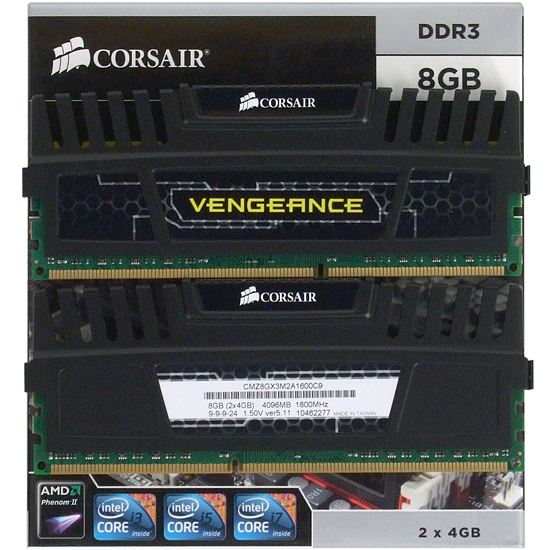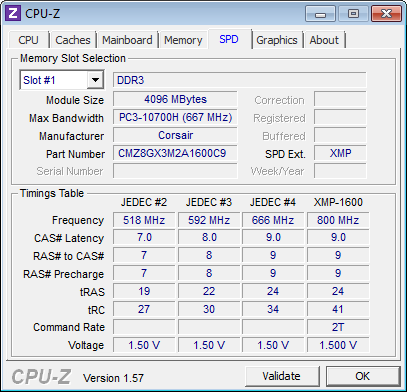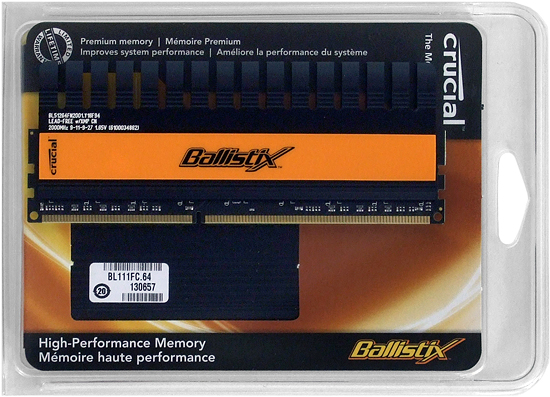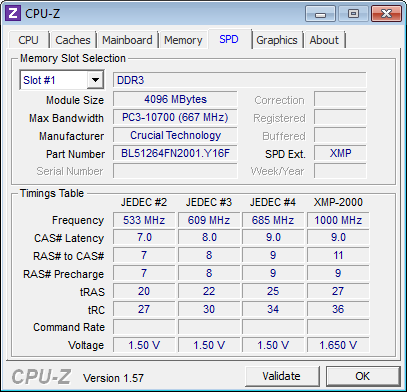Eight 8 GB (2 x 4 GB) Memory Kits For P67 Express, Rounded Up
Intel’s newest platform lineup has the same memory requirements as P55 Express, yet some of the modules available for it are rated differently. We discuss those differences on our quest to find the best performance/price in an 8 GB dual-channel kit.
Corsair And Crucial
Corsair Vengeance CMZ8GX3M2A1600C9
Rated at DDR3-1600 CAS 9-9-9-24, Corsair’s latest modules put stability, capacity, and compatibility ahead of frequency and latency. We find a 1.50 V rating written right on the module, which means that these should run on nearly any DDR3-based system.
Maintaining compatibility is easy, since Corsair programs these to default to DDR3-1333 CAS 9. A single XMP of DDR3-1600 runs at 1.50 V, but only Corsair knows for sure why this wasn’t included within normal SPD registers. We’re guessing the 2T command rate is the culprit, though reliance on XMP means that motherboards without this feature must be manually configured to run at the rated settings. We’ll use 1T exclusively in today’s test.
Also available in Blue (add a B to the end of the model number), Corsair offers a lifetime warranty to the original purchaser of its DRAM products.
Crucial Ballistix BL2KIT51264FN2001
Crucial did not update its Ballistix portfolio to reflect the limited BCLK adjustment range of Intel’s LGA 1155 platform, but instead lists its LGA 1156-spec DDR3-2000 as the highest performance 8 GB kit. The same kit turns up when searching “compatible memory” for some P67 motherboards, even though most builders can’t get the specified speed to run. We’ll test these at DDR3-1866 and DDR3-2133, both of which are valid settings for our platform.
That is to say, the DDR3-2000 rating isn’t a hardware problem; it’s more of a marketing issue. Our search of Crucial’s Web site for DDR3-1866 and DDR3-2133 yielded no 4 GB modules at all, and relabeling/reprogramming these at a standard ratio could have filled at least one of those gaps.
Get Tom's Hardware's best news and in-depth reviews, straight to your inbox.
Serial presence detect tells motherboards to use DDR3-1333 CAS 9 at boot, but anyone with an XMP-capable motherboards will also find this memory’s rated settings. Our test board set the correct DRAM ratio without the BCLK overclock, resulting in the expected DDR3-1866 data rate.
Crucial memory carries a lifetime warranty for the original purchaser.
-
hmp_goose What happened to "get DDR3-1333 with tight timing: You'll never be able to appreciate `faster' stuff"?Reply
stuff rated 7-7-7-18 ment something, I thought … -
enforcer22 MMk sorry goose more ram is almost always and i mean 99.99999% better then faster ram :) i never saw any differences in ram speed turning off t1 and t2 timings slowing it down to a crawl turning off dual channel.. NEVER gave me an effective visual result. But adding more ram always gave me an instant result. I had this same argument with someone last week.. Nice to now have proof he was wrong about faster ram meaning something :) My ram is rated at 1600 but i have it only set on 1333 :/Reply -
dalauder My DDR3 2000 CL9 runs @ 1915MHz CL6 just fine. And I had some DDR2 800 @ 1010MHz & DDR2 533 @ 727MHz. I think most RAM just OC's nicely. I've also had a few weaker sticks (DDR2 667 that can't go over 727MHz), but it all exceeds posted specs.Reply -
CyberAngel I'm expecting to get my 2*4GB + 2*4GB DDR2 800MHz this weekReply
BUT
If I could do it over again I'd get that overly expensive DDR3 motherboard and just 1GB of RAM then later add more RAM sticks
Whenever DDR4 comes I'll jump in with small sticks and upgrade to more RAM when it gets cheaper (due to 20nm->15nm shrink)
Well, that's when Windows 9 arrives and 16 cores is the mainstream (2017?) I hope I have enough money for 3D projector at QuadHD, 4feet by 8feet white wall... -
Onus I would like to have seen something like the G.Skill Value series tested, but it really looks like RAM just doesn't make all that much difference for games.Reply -
ubercake I know this wasn't the primary focus of the article, though it is a good example of how sending more juice to your RAM and upping the speed on it has no noticeable effect on gaming performance.Reply -
gaborbarla ubercakeI know this wasn't the primary focus of the article, though it is a good example of how sending more juice to your RAM and upping the speed on it has no noticeable effect on gaming performance.Agreed,Reply
I would like to see a cheaper stick thrown in there like my Kinston Standard 512M X 64 Non-ECC 1333MHz 240-pin Unbuffered DIMM (DDR3, 1.5V, CL9, FBGA, Gold)
These RAMs with 19" Alloy wheels dont really seem to be worth their pricetags.
I think it is safe to say it is better to spend money on a better graphics card or CPU, perhaps a PSU.




